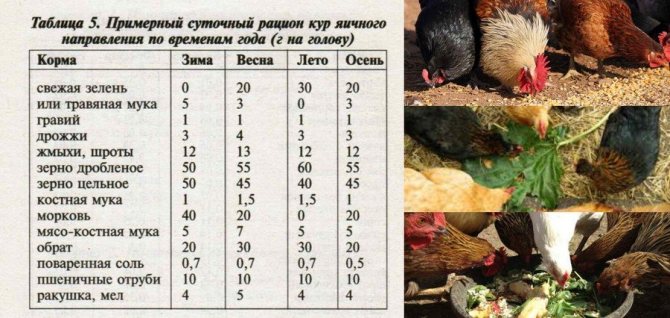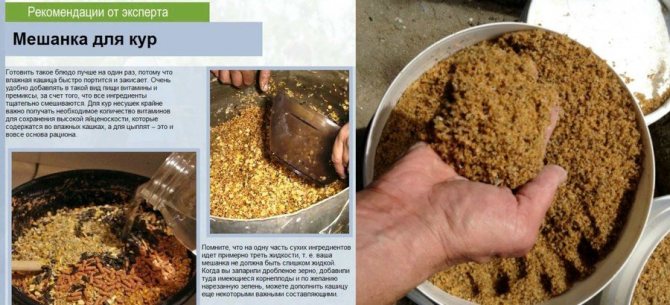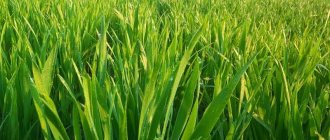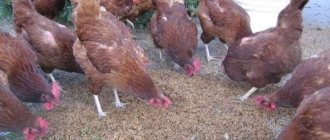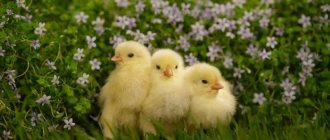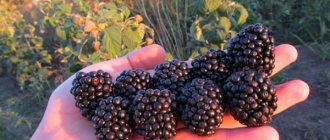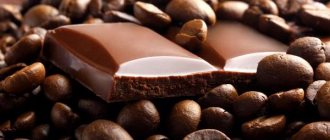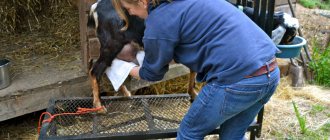288
no comments yet
0
The author of the article
Rasskazov Pavel
Reading time: 2 minutes
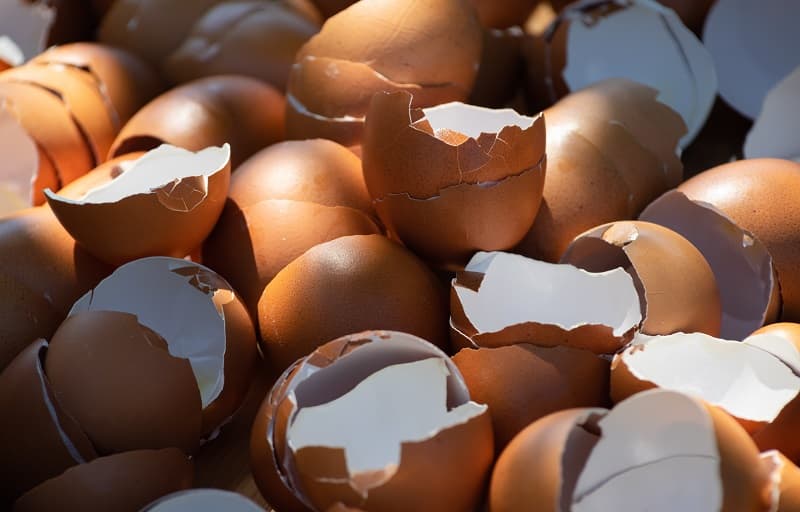
It may seem surprising to some that chickens sometimes begin to eat the shells of their own eggs with pleasure. This situation is not uncommon, and experienced poultry farmers immediately understand that their wards do not have enough calcium in the body, which is necessary for full growth and development.
Moreover, properly prepared eggshells can be introduced into the diet of chickens and chickens, as it has a number of beneficial properties.
Nutrition Basics
Many beginners are faced with the problem when tough babies suddenly start to get sick and die. Any wrong food intake is instantly reflected in the general condition of the crumbs. In the process of keeping, it is necessary to be careful with both day-old children and three-week-old adolescents.
When chicks are born, they still do not know how to eat. A small supply of nutrients is stored in the stomach sac, which will last for several hours. After the chickens are dry, offer them food immediately. If you watch the video, you can see that after the first grain is swallowed, the pecking instinct is firmly preserved in the brain.
For full development, babies need high-quality fresh food with a set of all the necessary microelements. The missing food instantly strikes the digestive system of young animals and a massive death begins. They recommend not to save money and purchase proven products.
It is important to comply with all sanitary and hygienic standards in feeding places. Professionals prefer to choose special feeders that do not allow birds with paws to get inside. Always remove uneaten residues before the next procedure.
It is advised to closely monitor the condition of all young animals. When weak or "sad" chicks appear, they are removed and raised outside the herd. If the patient does not want to eat on his own, then the procedure is carried out by force. The video shows how softened food with vitamins is injected into the beak using a pipette or a small syringe without a needle.
How to properly feed newly hatched birds?
Healthy chickens, like all cubs, are distinguished by increased activity. They are constantly moving around, digging out the bedding and pecking something out. By the way, they learn to peck food from the first days of life, they learn from the laying mother. Incubator chicks have feeding problems on the 1st day of housing. In this case, you need to show them how this is done using an "example". Knock the spilled rump with the tip of the knife, lift it up at the tip and drop it.
The chicks will begin to imitate you and will easily learn to peck at the feed. Like all babies, newly hatched chicks need frequent small meals. So the first day they feed the chicks every two hours, including at night. Chickens are given a different type of cereal at each meal., otherwise they will begin to peck out only those grains that they like and will not receive the necessary microelements.
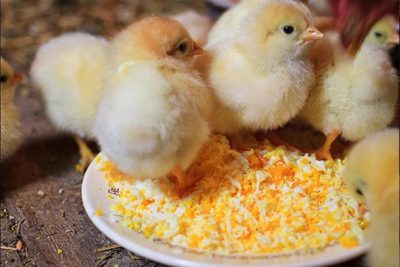

The diet of babies should be varied. The feeders are less than half full so that the chickens can eat all the feed, otherwise they will start scattering it. Before adding fresh food, remove the old one so that it does not rot. The height of the feeder should be such that the chicks can reach the feed but cannot climb into it. with legs.
Once in the feeder, they will fill the food with garbage and excrement. And eating such a mixture is fraught with an eating disorder, from which the entire brood can die.
Features of growing egg breeds
Caring for and feeding the chicks of ordinary chickens does not require large financial costs. At home, you can easily grow young animals both from the incubator and from under the quota. The whole process is broken down into several important stages.
Newborn
The faster the chick begins to peck, the better its digestive system will develop. Prolonged lack of food leads to a lack of nutrients, which contributes to developmental disorders. A little small corn grits are poured into a flat feeder or on the bottom of the "nursery".
A few years ago, poultry farmers used a hard-boiled egg to feed newborns. In the first hours, crushed yolk was given, and a little later - white. But modern veterinarians oppose this menu. Such a diet does not exert the necessary load on the stomach, therefore, the correct formation of muscles does not occur. After being transferred to coarse grain, the young develop a digestive upset.
In addition, feeding the yolk promotes the reproduction of unhealthy microflora in small chickens. The middle of the egg is very fatty, which negatively affects the general condition of the babies. Excess protein impairs the absorption of B vitamins.
Daily allowance
What should be fed to chickens from the first days? During this period, experts are allowed to diversify the diet. Now you can give:
- cereals (barley, corn, wheat);
- semolina;
- ground oatmeal flakes;
- millet.
It must be remembered that daily crumbs are fed every 2 hours. Often, babies eat only the grains they like, and scatter the rest. It is advised not to mix different types of cereals and give them separately.
Water is one of the most important elements, without which full development is impossible. Chickens love to climb into the drinker with their paws, so you need to monitor the cleanliness and freshness of the boiled liquid. If the livestock has diarrhea, then it is better to replace the drink with a weak solution of potassium permanganate.
Up to a week
Cereals alone are not enough for healthy development. Other products are gradually being introduced. Veterinarians recommend using cottage cheese, which is an excellent natural source of calcium and nitrogen. At first, it is mixed with the usual food: if there are no digestive disorders, then it can be used without additives.
From three days of age, it is allowed to drink liquid kefir, yogurt or whey. These foods contain beneficial probiotics and form a healthy microflora in the stomach. The young are happy to eat delicious food.
It is important to remember that milk should not be given to chicks: it causes diarrhea and sticks together the plumage.
In the first days of life, a varied menu must be provided. On the third day, it is allowed to give fresh herbs at home:
- dandelion;
- nettle;
- clover;
- plantain.
The leaves are slightly dried, and then cut into small pieces. From the fifth day, it is recommended to include onion feathers in the diet. The product not only supplies vitamins to the body, but also has a preventive effect on the stomach and protects against digestive infections.
Finely grated solid vegetables are gradually introduced into the diet:
- carrot;
- beets;
- pumpkin.
During this period, do not forget about vitamin preparations A, D, E and complexes containing yeast. It is important that the young are well fed, therefore, the goiter is checked for each chick. On the first day of life, you can start giving natural proteins: earthworms and boiled fish.
It is also important to remember the rules of hygiene.After each feeding with lactic acid products, the dishes are thoroughly washed and scalded with boiling water. The water and dry food containers are cleaned daily.
Older than a week
How to feed matured chickens at home? The maintenance of seven-day-old young stock has some differences. During this period of life, activity increases, and rapid growth is observed. The digestive system gets stronger and you don't have to worry about unexpected stomach upset after adding new ingredients.
Ten-day-old babies are given mixed rations consisting of an equal amount of cereals. Do not forget about greens and dairy products. Be sure to use veterinary drugs with vitamins and minerals.
For mature chicks, feed frequency is reduced by up to 4 or 5 times. Now we need to increase the portions and make sure that the youngsters eat everything. Hungry individuals must be manually fed.
Monthly
At 4 weeks old, chicks need to walk more. During this period, they get their own food, getting all the important trace elements. Begin to gradually add coarse grains. Wet mixes with bone meal and food waste perfectly saturate and give strength to the body for active action.
After 2 weeks, whole grains are recommended. Separate containers with fine gravel and sand are installed next to the feeders. To prevent chickens from eating eggs in the future, experts do not advise giving broken shells. It is better to give preference to ground shells.
Chickens after 3 months can already enter industrial compound feed into the menu. The mixture contains all trace elements and nutrients necessary for young animals. At the same time, do not forget about wet mash, fresh herbs and vegetables.
What to give for the first time?
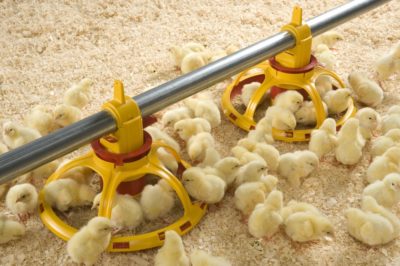

The simplest clue on how the day-old chicks are caring and feeding is to observe the brood in natural conditions. The laying hen already in the first 4-5 hours leads its offspring on an introductory walk to get food. Its main components are seeds, insects, greenery and sand. It will be reasonable to adhere to the natural diet of birds, of course, adapting it to the characteristics of the child's body of chickens, their conditions of keeping and feeding, the first 3 weeks.
For example, insects are replaced with yolk and cottage cheese, and seeds are replaced with cereals... From the first days of life, the feed for chickens should be based on hard-boiled and finely chopped yolk. We add cottage cheese and small cereals to it: semolina or corn. Chopped rolled oats are also good.
Groats are needed so that the yolk and cottage cheese do not stick together, and the chickens can easily peck and digest the feed. The composition of the first feed for 10 chicks of one day old chicks:
- 1 medium yolk.
- 3 tablespoons of cottage cheese.
- 2 tablespoons of cereal.
Features of feeding meat breeds
The broiler diet is quite different from the menu for layers, so it is important to know the intricacies of keeping the young. Chicks gain weight quickly and can weigh at least 1.5 kg at 2 months. There are 2 feeding methods.
Intensive
It is used in large farms and allows you to grow meat chickens all year round. The livestock is kept in cages from one day old to the moment of slaughter. Individuals are limited in movement, densely placed in pens.
It is important for broilers to maintain a constant indoor temperature (18 to 20 ° C) and high humidity (at least 65%). In the first week, the lighting works around the clock, and then gradually decreases. Such conditions of detention increase metabolism, so the bird constantly eats, increasing its mass.
From day old, broiler chickens are fed exclusively with industrial "starter" mixtures for meat breeds. They are high in protein, which is responsible for muscle building.
After the third week, they switch to the next type of menu - "growth". The "finishing" ration begins to be given from one month of age to slaughter.Both varieties contain a huge amount of nutrients, as a result of which the young grow quickly. Poultry needs to consume a lot of liquid on industrial feed.
Extensive
If there are no funds to purchase expensive professional mixtures, then this technique will do. Keeping broilers at home is a bit more difficult than keeping broilers from regular egg breeds. Chickens are very sensitive to food quality and changes.
In the early days, the content of the babies is completely the same. Starting from 5 days, 3 g of herbal flour are added to the food. After a week, fish waste is given, as well as vegetable cake. It is important to remember that protein is very important for crumbs of beef breeds.
On the twelfth day, broilers are transferred to a higher calorie content. Now you can offer fermented milk products, and replace 15% of the grain with boiled potatoes. Grated vegetables and herbs are combined with mineral and vitamin preparations.
After a month, protein foods are reduced to a minimum, giving preference to nutritious carbohydrates. After 4 weeks, the young should weigh about 3 kg. If the grooming was done correctly, then hormone supplements will not be needed for broiler growth.
Useful tips and techniques
Adult chickens are fed 3-4 times a day. In the morning, they give out a dry mixture or grain, for the second meal they use sprouted grain and a mash, and in the evening they give out only grain.
Note: Wet mash is prepared just before serving, and only the amount that they can eat is fed to the birds. This is a necessary condition so that the porridge does not deteriorate and the digestion process is not disturbed in birds.
In winter, warm liquids should be used to prepare moist mash. In addition, in winter, the number of meals is reduced to 4 times a day, and in the spring it increases again to five.
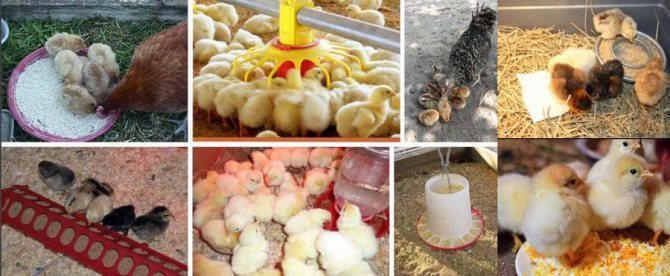

Fig. 4. Nutrition of adult chickens and chickens
Young chicks are fed 16-18 hours after hatching. To attract the chicks to the container, tap the rim with your fingers.
Note: If the chick refuses to eat on its own, it must be pipetted with egg yolk mixed with milk, and then given water (dip the beak in water).
In the first ten days of life, chickens eat up to eight times a day (every two hours). To make it easier for birds to eat food, it is laid out on paper sheets or thin plywood. After the chickens reach ten days of age, the number is reduced to six, and from three months they are transferred to the usual schedule.
Note: In order to shorten the night gap during which the birds will be without food, it is better to carry out the last grain distribution at eight o'clock in the evening, and the first feeding should be done early in the morning.
It is important that the evening feed is long and plentiful so that the birds are not hungry in the morning.
Features of feeding ducklings
If you need a breed for meat, then it is better to take musky chicks: they grow quickly and gain weight, and caring for them practically does not differ from keeping chickens. The process can be broken down into several age stages.
Newborn
On farms, such babies are often taken out under a brood hen. On the first day, the ducklings are immediately fed. For this, a crushed egg is offered. If the crumbs do not react to food, then it is recommended to sprinkle it on the back. Nature has made it so that only moving food attracts attention.
On the first day, do not forget about water. Indoor chicks have a greater need for fluid than other species. It is advised to use a weak solution of potassium permanganate. Don't want to drink yourself? Then you need to knock on the container with your finger and dip the beak into the drinker. Show three individuals, and the rest will immediately "get down to business."
It is necessary to monitor the cleanliness of dishes and be sure to wash them before serving food. They monitor the state of the young. If someone is “sad” or eats badly, he is isolated and force-fed.
Daily allowance
These days, you can gradually expand your diet by introducing new foods and vitamin concentrates. Indoor chicks begin to feed porridge with yogurt. They continue to add finely chopped boiled eggs and introduce them to low-fat cottage cheese. It is allowed to gradually knead cereal flour from any cereal:
- oats;
- corn;
- barley.
For children with waterfowl, the following must be available:
- sand;
- fine gravel;
- crushed seashells.
The elements not only saturate the body with important minerals, but also help grind food in the stomach. To help avoid digestive problems, in the early days of the musk ducklings continue to drink water with manganese. Remember to wash the dishes thoroughly after each meal.
After 3 weeks
Juicy foods are now allowed. Finely chopped nettle, cabbage will expand the usual menu. Be sure to add vitamin concentrates or fish oil.
These days, Indo-girls eat well boiled grated potatoes. Professionals replace 15% of the total diet with them. On the 40th day, children are taught to eat whole grains. First, it is introduced in a small amount into the mash, and then left as the last feeding before bedtime.
By the way, Indo-girls require special care. Waterfowl chicks must have tanks for swimming, otherwise all livestock will start splashing in the drinkers, staining the liquid. At the age of 55 days, the most fattened specimens are already slaughtered.
Knowing the needs of young Indo-duck, you can not worry about health problems. Our recommendations will help you choose the best option for both chickens and ducklings. Now raising poultry poultry will not be difficult.
Chicken mash
We recommend reading our other articles
- Fattening gobies for meat
- What to plant cherries on
- Candy for bees
- How to feed the grapes?
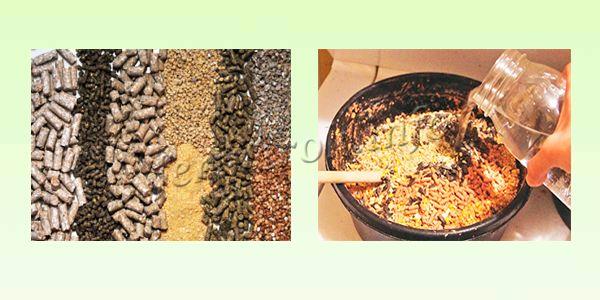

Chicken mash
The presence of wet mash in the diet is very useful for chickens, and besides, it is beneficial for the poultry farmer in financial terms. The fact is that some household waste can be added to the mash, for example, half-eaten porridge or boiled potato peel.
A mash is a mixture of grains, waste, vegetables, herbs, steamed with water or broth. You can add meat and bone or fish meal to the mash. Vegetables are usually boiled and chopped or pounded, such as pumpkin, carrots, potatoes, beets can be used.
It is convenient to add mineral dressings to the mash, such as shellfish and chalk. You can also dry and grind or grind the eggshells, you get a product that is very useful for chickens. But you need to make sure that the mash does not sit in the feeders for too long, as it tends to quickly deteriorate. And sour or rotten food can lead to serious consequences.
What feed to give preference
Taking proper care of your chicks ensures an active and healthy life. In traditional conditions, poultry farmers can offer their birds only a couple of types of food: hard or soft. Mainly, the diet of layers and babies is a skillful ratio of both types. What is the difference between them?
- Solid foods are grains or grass seeds. It is the grain that is taken as a basis when compiling food for birds. The best choice for chicks will be all kinds of cereals (millet, peas) and even waste that was obtained after grain processing.
- The mild type of feed consists of cereal flour, various vegetables, animal feed and greens. This also includes solid grain mixtures treated with hot or boiled water. Sometimes, for the manufacture of soft food, different types of flour, bran, boiled vegetables and herbs are used. The advantage of soft food is its rapid absorption by the body, therefore soft food is mainly used to feed small chickens. Also, this species is suitable for birds during molting and illness to enhance and diversify their diet.
Food for newborns
The most useful for small, 1-2-day-old chickens are special compound feed "zero", they are finely ground and contain vitamins, amino acids and vegetable fats. Wheat, corn, barley, peas are usually used as the main ingredients in them.
For one chicken, 1-2 tablespoons of compound feed are calculated per day. Starter feed is easy to prepare at home. Ingredients for 1 kg of mixture:
- 3 cups full of corn.
- 1/3 cup barley
- 1 glass of wheat.
- 1/2 cup low-fat kefir.
- 1 glass of cake.
Finely grind and mix all components, so it will be easier for chickens to digest and assimilate nutritious feed.

